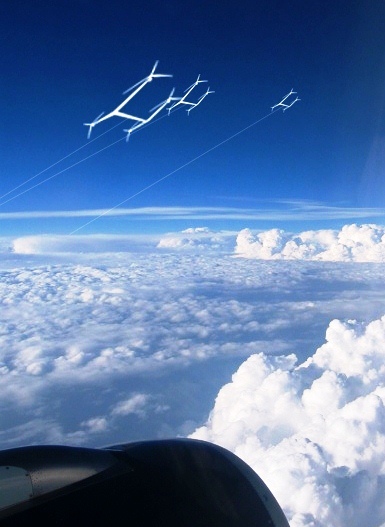Commercial airlines know jet streams well. Planes often hitch a ride on these strong, high-altitude atmospheric winds, which blow from west to east, to fly faster, and they are the reason why long-haul easterly flights (such as those between the US and Europe) are quicker than the corresponding westerly journeys.
Scientists are also familiar with these fierce and persistent winds, which occur at altitudes of 7 to 16 kilometres and have velocities from 90 to several hundred kilometres per hour. Some have even suggested we could harvest wind power from jet streams by developing appropriate airborne technology such as large kite-like wind-power generators. A group of researchers from the US and Australia estimated in 2007 that this potential renewable energy source could provide roughly 100 times the global demand of energy.
But research published this week in Earth System Dynamics, a journal of the European Geosciences Union, challenges this assumption. Lee Miller and collaborators from the Max Planck Institute for Biogeochemistry in Jena, Germany, calculated the maximum extractable energy from these streams to be about 200 times less than previously reported. They also warned that extracting wind power in this way can result in significant climate impacts.
The scientists pointed out that the high velocities of jet streams are not the result of a strong power source but are consequence of the near absence of friction high up in the atmosphere, as it is well-known in meteorology. The group shows in their calculations that, in fact, it takes very little power to accelerate and sustain these winds.
“It is this low energy generation rate that ultimately limits the potential use of jet streams as a renewable energy resource,” said Axel Kleidon, the study’s leader, in a press release.
A maximum of 7.5 terawatts (7.5 trillion watts), less than half of the 2010 global energy demand of 17 terawatts, can be extracted from jet streams, they determined. Previous studies arrived at much higher values because they used the wind velocity to estimate wind power, a method the Max-Planck researchers claim is flawed.
As with other weather systems, jet streams are in part caused by the fact that equatorial regions are warmer than the poles, which are less strongly heated by the sun. The differences in temperature and air pressure between these regions drive the atmosphere into motion creating the strong winds. These differences, rather than wind speeds, are what controls how much of the generated wind can be used as an energy resource.
The authors also estimated the climate impacts of extracting energy from jet streams. Wind turbines build up resistance when harvesting energy, which alters the flow of the wind. This disruption can slow down the entire climate system of our planet when substantial amounts of energy are extracted.
If 7.5 terawatts of energy were extracted from jet streams “the atmosphere would generate 40 times less wind energy than what we would gain from the wind turbines,” said Miller in a press release.
“This results in drastic changes in temperature and weather.”
By Bárbara Ferreira, EGU’s Media and Communications Officer

